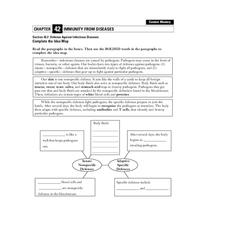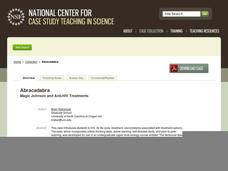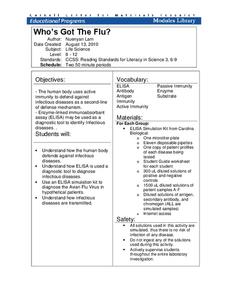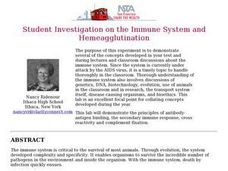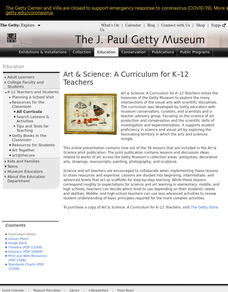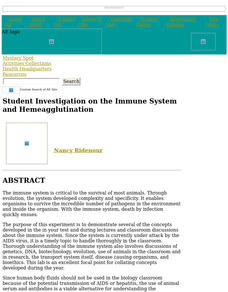Curated OER
The Human Impact on the Environment
Despite the typos and formatting issues, the Word document found here has some great potential. There are two questions that ask learners to put several events in a logical order; these could easily be made into a card sort activity....
Curated OER
The Nature of Disease
In this disease worksheet, students read information about infectious diseases, how they are transmitted, and how they are treated. Students then complete 6 fill in the blank questions.
Curated OER
Defense Against Infectious Diseases
For this infectious diseases worksheet, students read about the two types of defenses the body has against pathogens: innate (nonspecific) and adaptive (specific). Students then complete a graphic organizer by filling in 11 blanks.
Curated OER
Defense Against Infectious Diseases
In this infectious disease defense worksheet, high schoolers will review the immune system including acquired, antibody, and cellular immunity. Students will then compare passive and active immunity to infectious diseases. This worksheet...
Curated OER
Eukaryotic Cell Structure
In this cell structure worksheet, students review the structure and function of eukaryotic cells. Students also compare and contrast an animal cell with a plant cell. This worksheet has 15 fill in the blank, 8 true or false, and 7...
Curated OER
Autoimmune Disease
Students conduct Internet research on an autoimmune disease, and present the information in a PowerPoint presentation.
Curated OER
Immunity From Diseases
In this immunity worksheet, learners review vocabulary associated with how the body defends itself from diseases. This worksheet has 12 matching questions.
National Center for Case Study Teaching in Science
Abracadabra
How has Magic Johnson managed to stay so healthy, despite being HIV-positive for over 20 years? If you have ever taught about HIV and AIDS, you have most likely been asked such a question. By examining a case study and role-playing as...
Curated OER
Life in the Crystal Palace
Marine biologists research sea ice communities. Assign some groups to construct paper models of sea ice communities in winter, and some to construct models of them in summer. The lesson is simplistic, but the Internet resources provided...
Exploratorium
Salty Pits
Yuck, does my deodorant kill that? To test whether deodorant is anti-bacterial, class members use petri dishes to grow control bacteria and bacteria from sweat, and then compare them to see if deodorant effects the...
Kenan Fellows
The Little Stuff Can Make a Big Difference
Great things come in small packages! What better way to illustrate this point than a week-long look at nanotechnology? Earth science scholars explore water quality issues through lab activities, then research new innovations in nanotech...
Cornell University
Who’s Got The Flu?
Become an immunologist for the day. Scholars elicit the use of the enzyme-linked immunoabsorbent assay (ELISA) to diagnose an infectious disease. Through the process, they learn about the immune system response to infectious diseases.
Curated OER
USING the SCIENTIFIC METHOD for PROBLEM SOLVING
Students work in teams to map the scientific method as applied in a present day medical situation. Their collaboration of data and findings should lead to a mutual conclusion. Students watch a variety of video's concerning these situations.
Curated OER
Pandemics and Epidemics
High schoolers evaluate data related to population growth, along with problems and soultions: disease cvontrol. They are able to explain how changes in habitat may affect organisms. Students evaluate evolutionary theories and processes.
Curated OER
Pandemics
Students demonstrate their knowledge of past, present and future pandemics. They create timeline for the spread of Influenza Pandemic of 1918. They discuss parallels between outbreaks of influenza and bird flu.
Curated OER
Student Investigation on the Immune System and Hemeagglutination
Students perform an experiment to demonstrate the principles of antibody-antigen binding, the secondary immune response, cross reactivity, and complement fixation. The materials to be used include antibodies from a rabbit that was...
Curated OER
Some Similarities between the Spread of an Infectious Disease and Population Growth
If the infectious diseases and population growth instructional activity, students simulate the spread of an infectious disease by exchanging fluids in a lab activity. Students watch the spread of the disease and graph the spread of the...
Curated OER
Asexual Reproduction
In this reproduction worksheet, pupils identify the 5 major ways organisms reproduce asexually and list examples of organisms that reproduce in that manor. Then students complete 10 short answer questions.
Curated OER
How Genes Work Lesson Plan
High schoolers define the key terms that are the structure and function of DNA. In this genetics lesson students complete a lab activity in which they construct a model DNA structure.
Curated OER
Black Death
Students examine the diseases of Europeans in Medieval times. In this plagues lesson students examine plagues of the past and some new modern ones.
Curated OER
The Cantankerous Pathogen
High schoolers explore what factors influence the spread of infectious diseases. They explain how human manipulation of the environment affects the transmission of diseases.
Curated OER
Clearly Classified
Learners investigate plants and insects. In this science classification lesson plan, students create separate categories for insects and plants by characteristics. Learners discover scientific names of insects.
Curated OER
An Ounce of Prevention...
Students discuss current H.I.V. prevention strategies and adapt these strategies to address the spread of H.I.V. in developing countries. They analyze the results of an international AIDS conference called "The Urgent Search for an AIDS...
Curated OER
Student Investigation on the Immune System and Hemeagglutination
Students study laboratory protocol for hemagglutination experiments.


